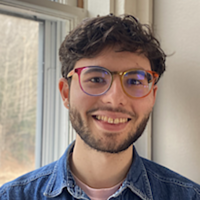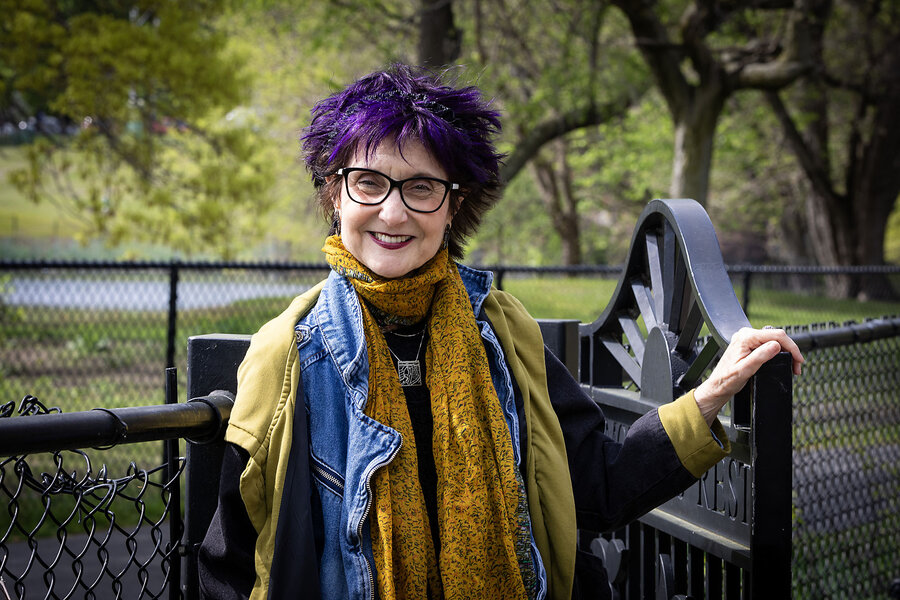How doulas and cafes help people break the last taboo – talking about death
Loading...
| Boston and New York
In cafes and community centers, classrooms and studios and online, conversations are challenging people’s long-held senses of fear and shame about contemplating death. And a new kind of role, the death educator, is springing up to help facilitate that destigmatization.
It’s a new look for an old vocation, says Cole Imperi, an author and thanatologist, or death researcher.
Why We Wrote This
A story focused onThe death of someone you love can feel like a very solitary – and silent – experience in America. Death educators are trying to create space for people to talk about everything from wills to questions about the afterlife and their own legacy.
“People who know about death, dying, grief, and loss have always existed and always been in our communities,” she says. Think clergy and bereavement committees, and among Indigenous groups, shamans or medicine women.
But in the United States, the trends of secularization and increased relocation have left a vacuum.
“If you came from a very conservative background or highly religious background, you might have been taught that you don’t talk about the dead,” she explains. “Many people are raised with different ideas about fear connected to death. People end up carrying this stuff with them throughout their whole lives.”
Where can you find a grandmother knitting a baby blanket next to a teenager crocheting a bikini top? “The cemetery” might not be the likeliest of answers.
Gabrielle Gatto certainly didn’t expect to encounter such a multigenerational scene the first time she arrived at Grieving & Weaving, a monthly meetup at Green-Wood Cemetery in New York City. But she says the event’s broad popularity speaks to universal interest in a topic that’s hard to find opportunities to talk about.
Both fiber artists probably had “very different motives” for attending, Ms. Gatto says. “But they’re both in that room because they want to talk about grief. They want to live and lead more thoughtful lives.”
Why We Wrote This
A story focused onThe death of someone you love can feel like a very solitary – and silent – experience in America. Death educators are trying to create space for people to talk about everything from wills to questions about the afterlife and their own legacy.
Ms. Gatto is Green-Wood’s resident death educator. She coordinates programs that include financial end-of-life planning seminars and the Mortality & Me book club. Last month, participants gathered for a class on the art of the condolence letter.
These offerings have been known to fill to capacity, Ms. Gatto says. Death remains a taboo in the outside world, but despite that – or perhaps because of it – community members are eager to come and engage with the subject.
“I get to see what people are yearning for, and then create events and programs around it – and make it, dare I say, a little fun, right?” she says. “It’s creating these more positive outlets for processing these kinds of feelings with community.”
For much of human history, the issues of death and dying have been predominantly handled though religion and rites of organized faith. But as the United States became more secular, the loss of customs left a void. Increasingly, people are looking for new ways to talk openly about a difficult subject – and often to help process the emotions surrounding it.
The result has been a surge in people focused explicitly on improving access to people’s literacy and comfort with the topic. It’s a niche that Cole Imperi, an author and thanatologist, or death researcher, argues is sorely needed.
“If you came from a very conservative background or highly religious background, you might have been taught that you don’t talk about the dead,” she explains. “Many people are raised with different ideas about fear connected to death. People end up carrying this stuff with them throughout their whole lives.”
What does death education look like?
In cafes and community centers, classrooms and studios and online, conversations are challenging people’s long-held senses of fear and shame about contemplating death. The role of death educator is springing up to help facilitate that destigmatization.
It’s a new look for an old vocation, says Ms. Imperi. “People who know about death, dying, grief, and loss have always existed and always been in our communities,” she says. Think clergy and bereavement committees, and among Indigenous groups, shamans or medicine women. “Typically, though, they’re not called death educators.”
The goal of today’s death education, says Anita Hannig, an anthropologist and author who studies death, is to find ways to address mortality without taking on the baggage that often accompanies it.
“We’re trying to create a safe container for us to have those conversations and not be labeled as morbid, suicidal, or weird and obsessed with death,” she says.
Some people’s first encounter might be a death cafe. Popularized in 2011 by Jon Underwood, these gatherings numbering in the thousands have taken place across 90 countries.
The rules of death cafes are simple: They are respectful and confidential. They shouldn’t have any particular agenda. They shouldn’t be held with the intention of leading participants to any particular conclusion. And they should, ideally, involve cake.
“We’re not selling anything. We’re not proselytizing for anything in the world. It’s not a grief session, but at heart, it’s a gathering of strangers who share the most fundamental commonality,” says Carol Lasky, a volunteer death cafe facilitator in Boston.
The unstructuredness of death cafes means participants can steer the conversation to larger topics, like questions of an afterlife, legacy, or a bucket list. But they can also find it helpful to dig into more functional topics, like funeral planning, wills, and burial methods. The ultimate goal, says Jay Davani, a facilitator in Providence, Rhode Island, is to build comfort so the practicalities of dying feel less daunting, and so they can be addressed before they become acute.
“You’re able to prepare yourself, your documents, your wishes,” she says.
Death education can also be a one-on-one experience. That’s exemplified by the death doula – a person who, like a birth doula, works to address the needs of a dying person and their loved ones, as a supplement to palliative or hospice care providers.
For Ms. Gatto, that work can start by helping people work through their questions and fears, or begin by creating plans for remembrance ceremonies.
When a client is dying, she finds doulas can add elements of humanity that might not otherwise factor into their care. For her aunt, who died recently, she tracked down chocolate ChapStick – helping address the loss of moisture in her lips, but also touching on her longtime love of chocolate pudding.
“I was able to come in and do those tiny little ritualesque things that felt very unique to her,” Ms. Gatto says. “I help curate conversations or scenarios like that for people. ... We’re here for you, and so compassionately. No judgment.”
Processing death via a community
But death education, proponents point out, is not just helpful for facing one’s own concerns. Young people who have less familiarity with bereavement can find it particularly meaningful to examine the phenomenon.
During the three semesters that Dr. Hannig offered an Anthropology of Death and Dying course at Brandeis University, at least one student each term would inevitably face a death in the family. She left it up to them whether to attend class.
Most of them said, “‘This is actually the most helpful thing for me, to come to class,’” she says. “‘Because here, I can actually process this huge thing that’s happened in my life. And in my other classes, I’m supposed to be OK, or it’s just not talked about.’”
That’s the core of the genre: finding ways to process one of life’s most challenging milestones, in community.
“For many of them,” Dr. Hannig says of her students, “it felt incredibly liberating.”









